
Minden is a census-designated place (CDP) in Douglas County, Nevada, United States. The population was 3,001 at the 2010 census. It is the county seat of Douglas County and is adjacent to the town of Gardnerville. It was founded in 1906 by Heinrich Friedrich Dangberg Jr., who named it after the town of Minden, in the German state of North Rhine-Westphalia, which was near his father's birthplace. A large share of the first settlers were Germans. Minden was founded on company land of the Dangberg Home Ranch and Dangberg commissioned most of the town's early buildings. Minden has had a post office since 1906.
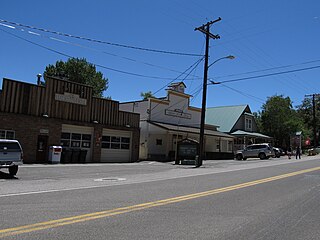
Genoa is an unincorporated town in Douglas County, Nevada, United States. Founded in 1851, it was the first settlement in what became the Nevada Territory. It is situated within Carson River Valley and is approximately 42 miles (68 km) south of Reno at 39.005,-119.846. The population was 939 at the 2010 census.
Frederic Joseph DeLongchamps was an American architect. He was one of Nevada's most prolific architects, yet is notable for entering the architectural profession with no extensive formal training. He has also been known as Frederick J. DeLongchamps, and was described by the latter name in an extensive review of the historic importance of his works which led to many of them being listed on the U.S. National Register of Historic Places in the 1980s.

The Virginia and Truckee 18 Dayton is a historic standard gauge steam locomotive on display in Carson City, Nevada. It spent its working life on the Virginia and Truckee Railroad.
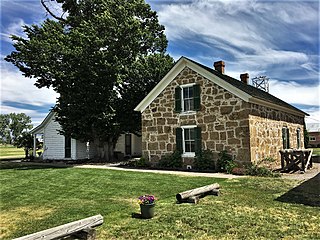
The Dangberg Home Ranch Historic Park is a Douglas County, Nevada, USA, park, preserving one of the state's first ranches.

The Lakeview Tithing Office, also known as the Bunnell Creamery, is a historic building located in Provo, Utah, United States. It is listed on the National Register of Historic Places.
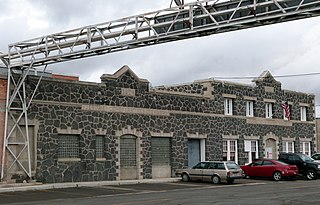
The Jerome Cooperative Creamery is a cooperative creamery and also refers to historic lava rock structures used by the creamery on Birch Street in Jerome, Idaho, United States. The structures were listed on the National Register of Historic Places on September 8, 1983. They were built in 1915, 1924, and 1933 by master stonemason H.T. Pugh who popularized the use of lava rock in the Jerome area.

The Borden Milk Co. Creamery and Ice Factory is a historical site in Tempe, Arizona. Built originally as an ice plant, it was altered to also produce pasteurized bottled milk. The Pacific Creamery Plant was sold in 1927, and it operated under the Borden name until its closure in 1953. The building stood empty until it was reopened as Four Peaks Brewery, a restaurant and regional brewery. The Borden operation had enough impact on the city that a new park was designated "Creamery Park" in 1999.
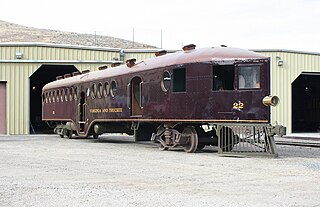
Virginia and Truckee Railway Motor Car 22, also called McKeen Motor Car 70, is a gasoline-powered railcar at the Nevada State Railroad Museum in Carson City in the U.S. state of Nevada. It was built for the Virginia and Truckee Railroad in 1910 by the McKeen Motor Car Company. Motor Car 22 was operated by the Virginia and Truckee until 1945, when it was sold off and became a diner until 1955. It eventually became the office and storage space for a plumbing business before it was donated to the Nevada State Railroad Museum in 1995. After a thorough study, the Museum undertook a restoration of the McKeen car in 1997. The restored motor car was unveiled in 2010, a century after it was originally delivered to the Virginia and Truckee. Motor Car 22 was listed on the National Register of Historic Places in 2005, and designated a National Historic Landmark in 2012. It is one of a few surviving McKeen railcars, and the only one that is operational.

Farmer's Bank of Carson Valley is a historic bank building located at 1596 Esmeralda Avenue in Minden, Nevada. The building was built in 1909 to house the Farmer's Bank of Carson Valley, which was chartered in the same year. H. F. Dangberg, the founder of Minden, commissioned the building, which was only the second building built in the town. In 1918, the bank outgrew its original building and moved to a larger building across the street. After the bank left the building, it was occupied by the Minden Post Office until 1974. The building has housed a variety of businesses since and is currently occupied by the Bank Parlor and Pub.

Farmer's Bank of Carson Valley is a historic bank building located at 1597 Esmeralda Avenue in Minden, Nevada. The bank was built from 1916 to 1918 to replace the original 1909 bank building, which the Farmer's Bank had outgrown. Prominent Nevada architect Frederic Joseph DeLongchamps designed the building in the Classical Revival style; the bank is one of many Neoclassical structures designed by DeLongchamps in Minden. The bank's design features a cornice with terra cotta tiles and bands, a flat roof with a low parapet, and an entrance portico with Ionic columns. The bank was built for Farmer's Bank organizer H. F. Dangberg, who was also the founder of Minden. The building served as a bank until 1968 and currently houses offices.

The Carson Valley Improvement Club Hall is a historic building located at 1606 Esmeralda Avenue in Minden, Nevada. The building was constructed in 1912 as a meeting hall for the Carson Valley Improvement Club. The two-story building features a variety of brickwork patterns but has an otherwise plain design. The Carson Valley Improvement Club used the building to host both community social events and town meetings. The building has served as the informal seat of government in Minden since its construction; after the Carson Valley Improvement Club moved out in 1920, the Minden Commercial Club and later the Minden Town Board continued to hold government meetings at the building. Though Minden is unincorporated, the groups meeting in this building have acted as local liaisons to Douglas County's government and have helped manage local government services. In addition, the building has continued to house a variety of social events, including concerts, movies, religious services, and basketball games.
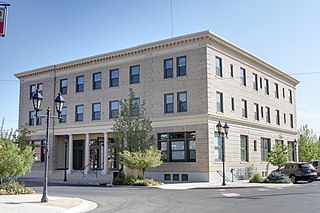
The Minden Inn is a historic hotel building located at 1594 Esmeralda Avenue in Minden, Nevada. Built from 1912 to 1916, the building was designed by prominent Nevada architect Frederic Joseph DeLongchamps in the Classical Revival style. The hotel was the largest commercial building in Minden and was operated by H. F. Dangberg, the founder of the town. The inn earned a reputation as "one of the finest small hotels on the West Coast" and was visited by a number of actors and celebrities who passed through Minden on the Virginia and Truckee Railroad. In addition, the hotel included a bar and gambling operations until 1987. The building now houses Douglas County offices.

The Minden Flour Milling Company is a historic flour mill located at 1609 U.S. Highway 395 in Minden, Nevada. Built in 1906, the mill was the largest of five flour mills built in the Carson Valley and is the only one still in existence. The building has a transitional design in two respects, as it reflects the change from early European-influenced mills to 20th-century American mills as well as the move from smaller rural mills to large mills built along railroads. The mill features a masonry bearing-wall style of construction, a concrete foundation considered novel at the time, and well-crafted masonry and woodwork. The operators of the mill had a significant influence on Minden commerce, as they were instrumental in both the extension of the Virginia and Truckee Railroad to the town and the expansion of electric power to the area. By the 1920s, the mill had become "one of the biggest milling concerns in the state"; it could process 100 barrels of flour a day and also produced chicken and cattle feed. The mill operated until the 1960s.

The Minden Wool Warehouse is a historic warehouse building located at 1615 Railroad Avenue in Minden, Nevada. Built in 1915, the warehouse was designed by prominent Nevada architect Frederic Joseph DeLongchamps. DeLongchamps designed the building for H. F. Dangberg, the founder of Minden, and the warehouse served as the headquarters for Dangberg's Dangberg Land and Livestock Company. Carson Valley farmers used the warehouse to store wool and potatoes before they were shipped out of Minden. The warehouse was later rented to the Minden Flour Company and a local creamery; it is now used as an office building by the Bently Nevada Corporation.
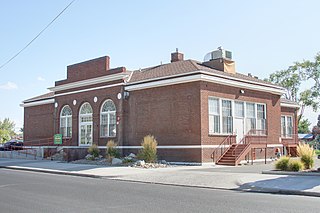
Minden Elementary School, also known as Minden Grammar School, is a historic school building located at 1638 Mono Avenue in Minden, Nevada. The Renaissance Revival school was built in 1918 at a cost of $14,291. The school replaced the county's first school, a 1908 building known as the "little green schoolhouse". The school operated until it closed in 1980 and now serves as an office building for the Douglas County School District.

The Arthur R. Hoard House, also known as the George P. Marston House, is a historic residence in Fort Atkinson, Wisconsin, United States. The house was owned by several important early families in the town, including two mayors and a state representative.

The Clarks Grove Cooperative Creamery is a historic creamery in Clarks Grove, Minnesota, United States. It was established in 1890 as one of the first cooperative creameries in Minnesota. The Clarks Grove Cooperative Creamery used new technology and a well-organized cooperative system. It became a model for the Minnesota dairy industry. Ten years later, there were more than 550 cooperative creameries in the state.
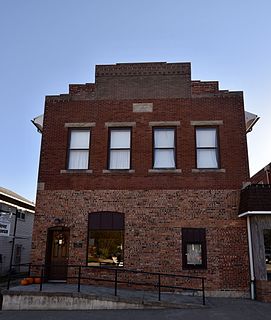
The Peterson Manufacturing Building, also known as the New London Cooperative Creamery, is a historic building located in New London, Iowa, United States. The first floor of this building was constructed in 1908 by John Edgar Peterson so he could expand his glove and mitten factory. Peterson was also instrumental in the establishing the First National Bank in New London and served as its president, the Henry County Telephone Company, the New London Improvement Company, and the New London Land Company. The second floor of this building was completed in 1909 by the local Masonic lodge. Peterson died in 1917 and glove and mitten factory closed briefly before it was reopened by the Fairfield Glove and Mitten Factory. In 1928 that factory closed and the building housed a creamery until 1968. After being used as a warehouse it was donated to the Dover Historical Society for a historical museum. The building was listed on the National Register of Historic Places in 1997.

The Creamery Package Manufacturing Company Building is a historic building at 1245 W. Washington Boulevard in the Near West Side neighborhood of Chicago, Illinois. Built in 1926, the building served as the headquarters for the Creamery Package Manufacturing Company, which was formed in 1887. The architecture firm of Gardner & Lindberg designed the three-story Colonial Revival building. The Creamery Package Manufacturing Company produced processing equipment and other goods for the dairy industry, which had a large presence in and around Chicago in the early 20th century. The company is representative of Chicago's significant food processing industry; the city's position as a transportation hub meant processing companies could quickly send their goods to larger customers in the food industry. The Creamery Package Manufacturing Company used the building until the 1970s.





















